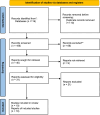Socio-economic determinants influencing adherence to secondary prophylaxis in patients with rheumatic heart disease: a systematic review
- PMID: 38989213
- PMCID: PMC11230804
- DOI: 10.1097/MS9.0000000000002164
Socio-economic determinants influencing adherence to secondary prophylaxis in patients with rheumatic heart disease: a systematic review
Abstract
Introduction: Rheumatic heart disease (RHD) poses a substantial global health challenge, especially impacting resource-limited nations, with over 40.5 million cases reported in 2019. The crucial role of Benzathine penicillin G in both primary and secondary prevention, particularly the latter, emphasizes its significance.
Method: Following PRISMA guidelines, our systematic review explored Medline, Scopus, Google Scholar, and Embase databases from 1990 to 2022. Registered with PROSPERO ), the review utilized quality appraisal tools, including the PRISMA checklist, Cochrane bias tool and Newcastle-Ottawa scale. The objective was to identify and stratify the impact of socio-economic factors on adherence to secondary prophylaxis in RHD.
Results and discussion: The impact of education on adherence has been found to be significant. Socially disadvantaged environments significantly influenced adherence, shaped by education, socio-economic status, and geographical location and access to healthcare. Surprisingly, lower education levels were associated with better adherence in certain cases. Factors contributing to decreased adherence included forgetfulness, injection-related fears, and healthcare provider-related issues. Conversely, higher adherence correlated with younger age, latent disease onset, increased healthcare resources, and easy access.
Conclusion: Patient education and awareness were crucial for improving adherence. Structured frameworks, community initiatives, and outreach healthcare programs were identified as essential in overcoming barriers to secondary prophylaxis. Taking active steps to address obstacles like long-distance commute, waiting time, injection fears, and financial issues has the potential to greatly improve adherence. This, in turn, can lead to a more effective prevention of complications associated with RHD.
Keywords: RHD; rheumatic heart disease; secondary prophylaxis.
Copyright © 2024 The Author(s). Published by Wolters Kluwer Health, Inc.
Conflict of interest statement
The authors have no conflict of interest to declare.Sponsorships or competing interests that may be relevant to content are disclosed at the end of this article.
Figures

Similar articles
-
Adherence to Secondary Prophylaxis for Acute Rheumatic Fever and Rheumatic Heart Disease: A Systematic Review.Curr Cardiol Rev. 2017;13(2):155-166. doi: 10.2174/1573403X13666170116120828. Curr Cardiol Rev. 2017. PMID: 28093988 Free PMC article.
-
Beyond the black stump: rapid reviews of health research issues affecting regional, rural and remote Australia.Med J Aust. 2020 Dec;213 Suppl 11:S3-S32.e1. doi: 10.5694/mja2.50881. Med J Aust. 2020. PMID: 33314144
-
Adherence to penicillin treatment is essential for effective secondary prevention of rheumatic heart disease: a systematic review and meta-analysis.Ann Med Surg (Lond). 2024 Feb 28;86(4):2116-2123. doi: 10.1097/MS9.0000000000001833. eCollection 2024 Apr. Ann Med Surg (Lond). 2024. PMID: 38576943 Free PMC article. Review.
-
A qualitative examination of secondary prophylaxis in rheumatic heart disease: factors influencing adherence to secondary prophylaxis in Uganda.Glob Heart. 2015 Mar;10(1):63-69.e1. doi: 10.1016/j.gheart.2014.10.001. Glob Heart. 2015. PMID: 25754568
-
Adherence to secondary antibiotic prophylaxis among patients with acute rheumatic fever and/or rheumatic heart disease: a systematic review and meta-analysis.BMJ Open. 2024 Nov 14;14(11):e082191. doi: 10.1136/bmjopen-2023-082191. BMJ Open. 2024. PMID: 39542478 Free PMC article.
References
-
- Beaton A, Okello E, Rwebembera J, et al. . Secondary antibiotic prophylaxis for latent rheumatic heart disease. N Engl J Med 2022;386:230–240. - PubMed
-
- Beaton A, Okello E, Rwebembera J, et al. . ADHERENCE TO SECONDARY PROPHYLAXIS OF RHEUMATIC FEVER IN PATIENTS WITH RHEUMATIC HEART DISEASE IN RURAL AREAS. Pak Heart J 51(3). doi:10.47144/phj.v51i3.1538 - DOI
-
- Nemani L, Maddury J, Barik R, et al. . A Cross-sectional study to look at the determinants of poor adherence to secondary penicillin prophylaxis for rheumatic heart disease at a tertiary care center in South India. J Clin Prev Cardiol 2018;7:5.
Publication types
LinkOut - more resources
Full Text Sources
